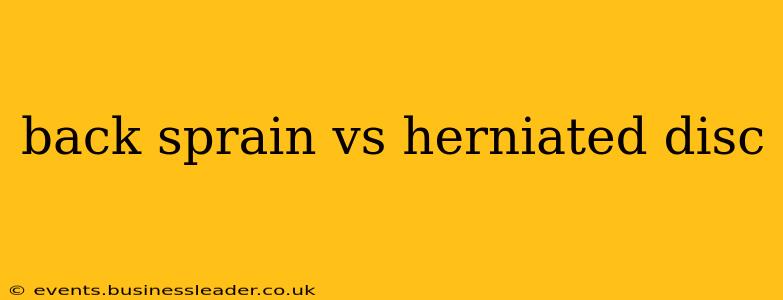Back pain is a common ailment, affecting millions worldwide. Two frequent causes of lower back pain are back sprains and herniated discs. While both can cause significant discomfort, they differ in their underlying causes, symptoms, and treatment approaches. Understanding these differences is crucial for effective diagnosis and management.
What is a Back Sprain?
A back sprain, also known as a lumbar sprain, involves an injury to the ligaments surrounding the vertebrae in your spine. Ligaments are tough, fibrous tissues that connect bones. A sprain occurs when these ligaments are stretched or torn, often due to a sudden twisting motion, lifting a heavy object incorrectly, or a fall. The injury typically affects the soft tissues around the spine, rather than the bones or discs themselves.
Symptoms of a Back Sprain
Symptoms of a back sprain can vary in severity but often include:
- Sharp, sudden pain: Often felt immediately after the injury.
- Muscle spasms: Involuntary contractions of back muscles.
- Limited range of motion: Difficulty bending, twisting, or extending the back.
- Swelling and tenderness: Around the affected area.
- Pain that worsens with movement: Activities like bending, lifting, or twisting exacerbate the pain.
What is a Herniated Disc?
A herniated disc, also known as a slipped or ruptured disc, occurs when the soft, gel-like center of an intervertebral disc pushes through a tear in the tough outer layer (annulus fibrosus). These discs act as cushions between the vertebrae, absorbing shock and allowing for movement. When a disc herniates, it can press on nearby nerves, causing pain, numbness, and weakness.
Symptoms of a Herniated Disc
Symptoms of a herniated disc can be more significant and widespread than a back sprain, including:
- Pain radiating down the leg (sciatica): This is a common symptom, characterized by pain that travels down the buttock and leg along the sciatic nerve.
- Numbness and tingling: In the leg or foot.
- Muscle weakness: In the leg or foot.
- Pain that worsens with sitting or coughing: Increased pressure on the herniated disc.
Back Sprain vs. Herniated Disc: Key Differences Summarized
| Feature | Back Sprain | Herniated Disc |
|---|---|---|
| Cause | Ligament injury (stretch or tear) | Disc rupture, pressing on nerves |
| Primary Pain | Localized back pain | Back pain radiating to leg (sciatica) |
| Other Symptoms | Muscle spasms, limited range of motion | Numbness, tingling, muscle weakness |
| Severity | Varies, can be mild to moderate | Can be severe, requiring medical intervention |
How are Back Sprains and Herniated Discs Diagnosed?
Diagnosis typically involves a physical examination, where your doctor will assess your range of motion, palpate your back for tenderness, and evaluate your neurological function. Imaging tests like X-rays, MRIs, or CT scans may be necessary to confirm the diagnosis and rule out other conditions. An MRI is particularly useful for visualizing herniated discs.
What is the Treatment for a Back Sprain?
Treatment for a back sprain usually focuses on conservative measures:
- Rest: Avoid activities that aggravate the pain.
- Ice: Apply ice packs to reduce swelling and pain.
- Over-the-counter pain relievers: Such as ibuprofen or acetaminophen.
- Physical therapy: To strengthen back muscles and improve flexibility.
What is the Treatment for a Herniated Disc?
Treatment for a herniated disc may involve a similar approach as a sprain initially, but more aggressive interventions might be necessary in severe cases:
- Conservative treatment: Rest, ice, pain relievers, and physical therapy.
- Epidural steroid injections: To reduce inflammation around the nerve roots.
- Surgery: In cases where conservative treatments fail to provide relief, surgery may be an option.
How Long Does it Take to Recover From a Back Sprain or Herniated Disc?
Recovery time varies greatly depending on the severity of the injury and individual factors. A back sprain may heal within a few weeks to a couple of months with appropriate treatment. Recovery from a herniated disc can take longer, sometimes months or even years, depending on the treatment approach and the individual’s response.
Can a Back Sprain Turn Into a Herniated Disc?
While a back sprain itself doesn't directly turn into a herniated disc, repetitive strain or trauma to the spine can increase the risk of both conditions. If you experience persistent or worsening back pain after a sprain, it's crucial to seek medical attention to rule out more serious issues.
This information is intended for educational purposes only and does not constitute medical advice. Always consult with a healthcare professional for any health concerns or before making any decisions related to your health or treatment.
